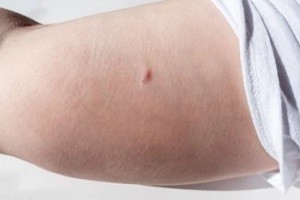Why Does It Take 7 Days For Nexplanon To Work effectively as a contraceptive? WHY.EDU.VN provides a detailed explanation of the 7-day rule, the science behind Nexplanon’s effectiveness, and what to expect during the initial period after insertion. Discover reliable information about Nexplanon insertion, hormone release, and contraceptive methods.
1. Understanding Nexplanon: A Comprehensive Overview
Nexplanon is a highly effective form of long-acting reversible contraception (LARC). It is a small, flexible plastic rod, approximately 4 cm in length and 2 mm in diameter, that is inserted subdermally (under the skin) in the upper arm. Once implanted, it continuously releases a progestin hormone called etonogestrel, which prevents pregnancy for up to three years. Nexplanon, a matchstick-sized device, provides a discreet and reliable method for preventing pregnancy, working by preventing ovulation, thickening cervical mucus, and thinning the uterine lining.
1.1. How Nexplanon Prevents Pregnancy
Nexplanon’s effectiveness stems from its multi-faceted approach to preventing pregnancy:
- Ovulation Inhibition: The primary mechanism of action is the suppression of ovulation. Etonogestrel inhibits the release of luteinizing hormone (LH), which is necessary for the maturation and release of an egg from the ovary.
- Cervical Mucus Thickening: Etonogestrel causes the cervical mucus to thicken, making it difficult for sperm to travel through the cervix and into the uterus.
- Endometrial Thinning: The hormone also thins the lining of the uterus (endometrium), making it less receptive to implantation of a fertilized egg.
1.2. Benefits of Nexplanon
Nexplanon offers several advantages over other forms of contraception, including:
- High Effectiveness: With a failure rate of less than 1%, Nexplanon is one of the most effective forms of contraception available.
- Long-Acting: A single Nexplanon implant provides continuous contraception for up to three years, eliminating the need for daily or monthly maintenance.
- Reversible: Fertility returns rapidly after removal of the implant.
- Estrogen-Free: Nexplanon contains only progestin, making it a suitable option for women who cannot or prefer not to use estrogen-containing contraceptives.
- Convenient: Once inserted, Nexplanon requires no further action from the user.
- Discreet: The implant is not visible and cannot be felt by others.
1.3. Potential Side Effects
Like all medications, Nexplanon can cause side effects. Common side effects include:
- Changes in Menstrual Bleeding Patterns: This is the most common side effect and can include irregular bleeding, spotting, prolonged bleeding, or absence of periods.
- Headaches
- Acne
- Weight Changes
- Breast Tenderness
- Mood Changes
These side effects are usually mild and tend to decrease over time. However, if they are bothersome or persistent, it is important to consult with a healthcare provider.
2. The 7-Day Rule: Why the Waiting Period?
The “7-day rule” is a guideline recommended by healthcare providers regarding the timing of Nexplanon insertion and the need for backup contraception. This rule addresses the question, “Why does it take 7 days for Nexplanon to work?” The timing of Nexplanon insertion in relation to a woman’s menstrual cycle is crucial in determining when the implant becomes fully effective in preventing pregnancy.
2.1. Understanding the Menstrual Cycle
To understand the 7-day rule, it’s helpful to review the basics of the menstrual cycle. The menstrual cycle is a recurring series of hormonal and physical changes that occur in a woman’s body in preparation for pregnancy. The cycle is typically around 28 days long, although it can vary from woman to woman. The first day of menstruation (bleeding) is considered day 1 of the cycle.
2.2. Rationale Behind the 7-Day Rule
The 7-day rule is based on the fact that the ovaries may already be preparing to release an egg when Nexplanon is inserted. If Nexplanon is inserted after ovulation has already occurred, or is about to occur, there is a chance that fertilization could happen before the hormone from the implant can fully suppress ovulation. The seven-day period ensures that the progestin hormone has enough time to reach a sufficient level in the body to effectively prevent ovulation.
2.3. Specific Scenarios for Nexplanon Insertion
- Insertion During the First 5 Days of Menstruation: If Nexplanon is inserted within the first five days of the menstrual cycle (i.e., the first five days of bleeding), it is considered effective immediately. In this case, no backup contraception is required. This is because, during this time, it is unlikely that ovulation is imminent or has already occurred.
- Insertion After Day 5 of Menstruation: If Nexplanon is inserted after the fifth day of the menstrual cycle, backup contraception (such as condoms) should be used for the first seven days following insertion. This allows the progestin hormone released by the implant to build up to a level that will reliably prevent ovulation.
2.4. What Happens if the 7-Day Rule is Not Followed?
If Nexplanon is inserted after day 5 of the menstrual cycle and backup contraception is not used for seven days, there is a risk of pregnancy if intercourse occurs during that time. It is crucial to adhere to the 7-day rule to ensure that the contraceptive protection is effective from the start.
3. Detailed Look at the Science: Hormone Levels and Ovulation Suppression
The effectiveness of Nexplanon hinges on maintaining a consistent level of etonogestrel in the bloodstream to prevent ovulation. It typically takes about seven days for the hormone levels to reach the point where ovulation is reliably suppressed.
3.1. Etonogestrel Release and Absorption
After insertion, Nexplanon begins releasing etonogestrel at a controlled rate. The hormone is absorbed into the bloodstream and distributed throughout the body. The rate of release is initially higher and gradually decreases over the three-year period.
3.2. Time to Reach Effective Hormone Levels
It takes approximately seven days for etonogestrel levels in the blood to reach a concentration that consistently inhibits ovulation in most women. This is why the 7-day rule is recommended when Nexplanon is inserted outside the first five days of the menstrual cycle.
3.3. Individual Variation
While the 7-day rule is a general guideline, it is important to note that individual responses to Nexplanon can vary. Some women may achieve effective hormone levels sooner than seven days, while others may take longer. However, to ensure maximum protection, it is always best to follow the recommended guidelines.
3.4. Monitoring Hormone Levels
In most cases, it is not necessary to monitor etonogestrel levels in the blood after Nexplanon insertion. However, in certain situations, such as in women who are overweight or taking medications that may interfere with hormone absorption, a healthcare provider may consider monitoring hormone levels to ensure adequate contraceptive protection.
4. Practical Guide: Getting Started with Nexplanon
If you’re considering Nexplanon, here’s a practical guide to help you get started:
4.1. Consultation with a Healthcare Provider
The first step is to schedule a consultation with a healthcare provider, such as a gynecologist or family doctor. During the consultation, you can discuss your medical history, any concerns you may have, and whether Nexplanon is the right contraceptive option for you.
4.2. Medical History and Examination
Your healthcare provider will take a detailed medical history, including any allergies, medications you are taking, and any underlying medical conditions. They may also perform a physical examination, including a pelvic exam.
4.3. Scheduling the Insertion
If you decide to proceed with Nexplanon, your healthcare provider will schedule the insertion appointment. They will discuss the timing of the insertion in relation to your menstrual cycle and whether you will need backup contraception.
4.4. The Insertion Procedure
The Nexplanon insertion procedure is typically performed in the healthcare provider’s office and takes only a few minutes. The area on your upper arm where the implant will be inserted is cleaned and numbed with a local anesthetic. A special applicator is then used to insert the implant under the skin.
4.5. Post-Insertion Care
After the insertion, a small bandage will be placed over the insertion site. You may experience some bruising, swelling, or tenderness in the area for a few days. Follow your healthcare provider’s instructions for post-insertion care, which may include keeping the area clean and dry and avoiding heavy lifting or strenuous activity for a few days.
5. Managing Expectations: What to Expect After Nexplanon Insertion
It’s important to have realistic expectations about what to expect after Nexplanon insertion.
5.1. Changes in Menstrual Bleeding
As mentioned earlier, changes in menstrual bleeding patterns are common after Nexplanon insertion. Some women experience lighter, shorter periods, while others have irregular bleeding or spotting. Some women may stop having periods altogether. These changes are usually not harmful and tend to decrease over time.
5.2. Other Potential Side Effects
In addition to changes in menstrual bleeding, you may experience other side effects, such as headaches, acne, weight changes, breast tenderness, or mood changes. These side effects are usually mild and tend to resolve on their own.
5.3. When to Contact Your Healthcare Provider
Contact your healthcare provider if you experience any of the following:
- Severe pain or swelling in the arm
- Signs of infection at the insertion site (redness, warmth, pus)
- Heavy or prolonged bleeding
- Severe headaches or migraines
- Depression or mood changes
- Unexplained weight gain or loss
- A lump or mass in your breast
- Yellowing of the skin or eyes (jaundice)
5.4. Routine Checkups
It’s important to have routine checkups with your healthcare provider while using Nexplanon. They will monitor your overall health and address any concerns you may have.
6. Nexplanon and Other Medications: Potential Interactions
Certain medications can interfere with the effectiveness of Nexplanon.
6.1. Medications That May Reduce Effectiveness
Some medications can increase the metabolism of etonogestrel, reducing its levels in the blood and potentially decreasing the effectiveness of Nexplanon. These medications include:
- Enzyme-Inducing Anticonvulsants: Phenytoin, carbamazepine, barbiturates
- Rifampin: An antibiotic used to treat tuberculosis
- Griseofulvin: An antifungal medication
- St. John’s Wort: An herbal supplement
6.2. Recommendations for Women Taking These Medications
If you are taking any of these medications, it is important to discuss this with your healthcare provider. They may recommend using a higher dose of progestin or using a non-hormonal form of contraception, such as a copper IUD.
6.3. Other Potential Interactions
Nexplanon may also interact with other medications, such as certain antibiotics and antifungals. Be sure to inform your healthcare provider of all medications you are taking, including prescription drugs, over-the-counter medications, and herbal supplements.
7. Comparing Nexplanon to Other Contraceptive Methods
Nexplanon is just one of many contraceptive options available. Here’s a comparison to some other common methods:
| Contraceptive Method | Effectiveness (Typical Use) | Advantages | Disadvantages |
|---|---|---|---|
| Nexplanon | >99% | Long-acting, reversible, discreet | Irregular bleeding, potential side effects |
| IUD (Hormonal) | >99% | Long-acting, reversible | Irregular bleeding, potential side effects |
| IUD (Copper) | >99% | Long-acting, non-hormonal | Heavier periods, potential for cramping |
| Birth Control Pills | 91% | Regulates periods, reduces acne | Requires daily adherence, potential side effects |
| Condoms | 85% | Protects against STIs | Requires correct and consistent use |
| Depo-Provera Shot | 94% | Convenient, less frequent dosing | Irregular bleeding, weight gain, bone density loss |



7.1. Choosing the Right Method
The best contraceptive method for you depends on your individual needs, preferences, and medical history. Consider factors such as effectiveness, convenience, side effects, cost, and whether you want to protect against STIs.
7.2. Discussing Your Options with Your Healthcare Provider
It’s important to discuss your contraceptive options with your healthcare provider. They can help you weigh the pros and cons of each method and choose the one that is right for you.
8. Troubleshooting Common Issues with Nexplanon
While Nexplanon is generally safe and effective, some women may experience problems or have questions about its use.
8.1. Missing Periods
It is common for women using Nexplanon to experience changes in their menstrual bleeding patterns, including missing periods. If you have missed a period and are concerned about pregnancy, it is best to take a pregnancy test.
8.2. Persistent Bleeding or Spotting
Some women experience persistent bleeding or spotting after Nexplanon insertion. This is usually not harmful and tends to decrease over time. However, if the bleeding is heavy or bothersome, contact your healthcare provider.
8.3. Expulsion
In rare cases, the Nexplanon implant can be expelled from the arm. If you suspect that your implant has been expelled, contact your healthcare provider immediately.
8.4. Difficulty with Removal
In some cases, the Nexplanon implant can be difficult to remove. This may be due to scar tissue formation or migration of the implant. If you are having difficulty with removal, your healthcare provider may refer you to a specialist.
8.5. Nexplanon and Weight Gain
Some users report weight gain after Nexplanon insertion. While clinical studies have not definitively linked Nexplanon to weight gain, individual experiences can vary. Maintaining a healthy diet and exercise regimen can help manage weight.
8.6. Nexplanon and Mood Changes
Mood changes, including anxiety and depression, have been reported by some Nexplanon users. If you experience significant mood changes, consult with your healthcare provider to discuss potential management strategies or alternative contraceptive options.
9. Frequently Asked Questions (FAQs) About Nexplanon
Here are some frequently asked questions about Nexplanon:
9.1. How effective is Nexplanon?
Nexplanon is over 99% effective in preventing pregnancy.
9.2. How long does Nexplanon last?
Nexplanon is effective for up to three years.
9.3. Does Nexplanon protect against STIs?
No, Nexplanon does not protect against STIs.
9.4. Can I get pregnant immediately after Nexplanon removal?
Fertility returns rapidly after Nexplanon removal.
9.5. Will Nexplanon cause weight gain?
Weight gain is a possible side effect, but it is not experienced by all women.
9.6. Will my periods stop with Nexplanon?
Some women stop having periods with Nexplanon, while others experience irregular bleeding or spotting.
9.7. Can I feel the Nexplanon implant in my arm?
Yes, you should be able to feel the implant in your arm. If you cannot feel it, contact your healthcare provider.
9.8. Can Nexplanon be used while breastfeeding?
Yes, Nexplanon is safe to use while breastfeeding.
9.9. Does Nexplanon cause birth defects if I get pregnant while using it?
There is no evidence that Nexplanon causes birth defects if you get pregnant while using it. However, it is important to discontinue use immediately if you become pregnant.
9.10. How much does Nexplanon cost?
The cost of Nexplanon varies depending on your insurance coverage and the healthcare provider.
10. Resources and Support for Nexplanon Users
There are many resources available to help you learn more about Nexplanon and connect with other users.
10.1. Websites and Online Forums
Numerous websites provide information about Nexplanon, including the official Nexplanon website, the Planned Parenthood website, and the American College of Obstetricians and Gynecologists (ACOG) website. Online forums and support groups can also be helpful for connecting with other Nexplanon users and sharing experiences.
10.2. Healthcare Providers
Your healthcare provider is the best resource for answering your questions about Nexplanon and providing personalized advice.
10.3. Support Groups
Support groups, either in-person or online, can provide a safe and supportive environment for sharing experiences and learning from others.
11. Staying Informed: Recent Updates and Research on Nexplanon
The field of contraception is constantly evolving, and new research is always emerging. Here are some recent updates and research findings related to Nexplanon:
11.1. Extended Use Beyond Three Years
Some studies have suggested that Nexplanon may remain effective for longer than three years. However, more research is needed to confirm these findings.
11.2. Interactions with New Medications
As new medications are developed, it is important to stay informed about potential interactions with Nexplanon. Consult with your healthcare provider before starting any new medications.
11.3. Impact on Bone Density
Some studies have raised concerns about the potential impact of progestin-only contraceptives on bone density. However, the effects appear to be minimal and reversible after discontinuation of use.
11.4. Mental Health Considerations
Recent research has focused on the potential link between hormonal contraceptives and mental health. While more research is needed, it is important to be aware of the potential for mood changes and to seek help if needed.
12. Conclusion: Making an Informed Decision About Nexplanon
Nexplanon is a highly effective and convenient form of contraception that offers many advantages. However, it is important to weigh the pros and cons carefully and to discuss your options with your healthcare provider. By staying informed and proactive, you can make an informed decision about whether Nexplanon is the right choice for you. Remember, the 7-day rule is a crucial aspect of ensuring its effectiveness when starting Nexplanon, so be sure to adhere to the guidelines provided by your healthcare provider.
If you’re seeking reliable answers to your questions about contraception, women’s health, or any other topic, visit WHY.EDU.VN. Our team of experts is dedicated to providing accurate, up-to-date information to help you make informed decisions about your health and well-being. Don’t hesitate to reach out with your questions – we’re here to help. Contact us at 101 Curiosity Lane, Answer Town, CA 90210, United States. Whatsapp: +1 (213) 555-0101. Website: WHY.EDU.VN. Let why.edu.vn be your trusted source for knowledge and support.